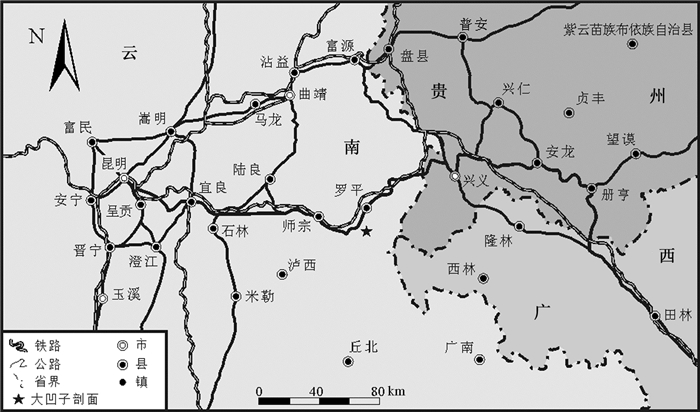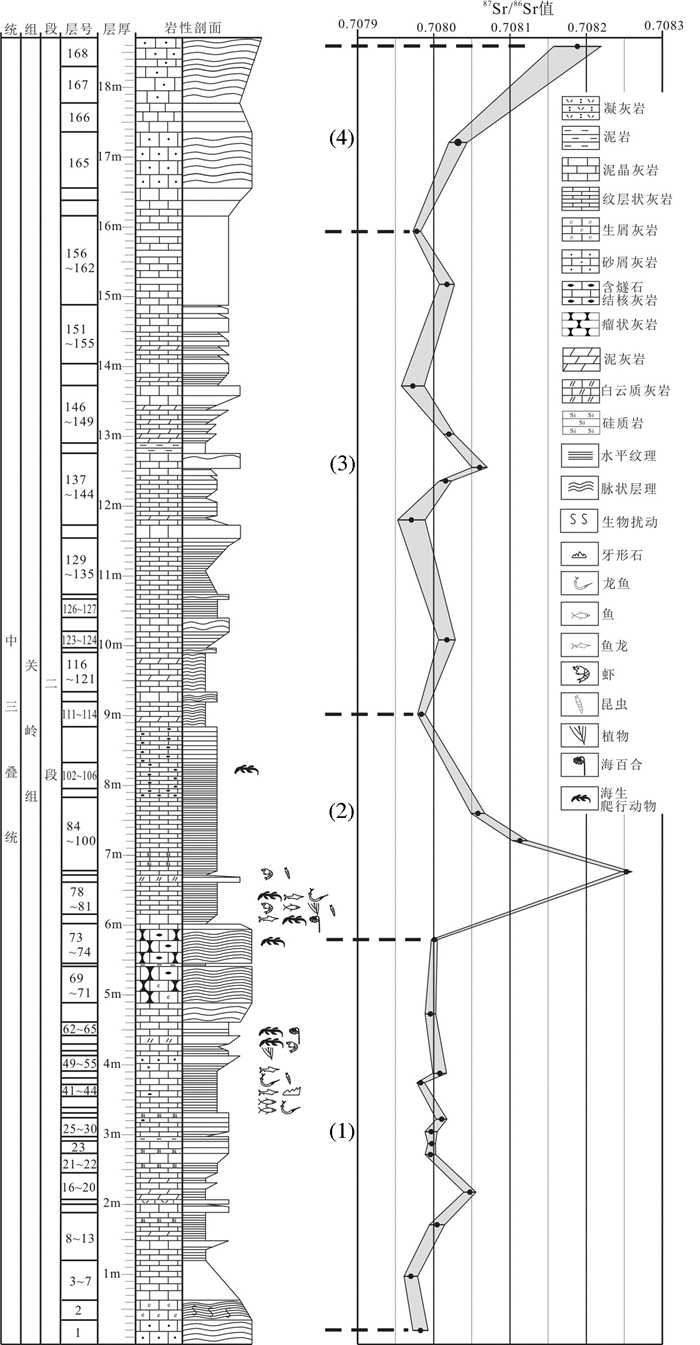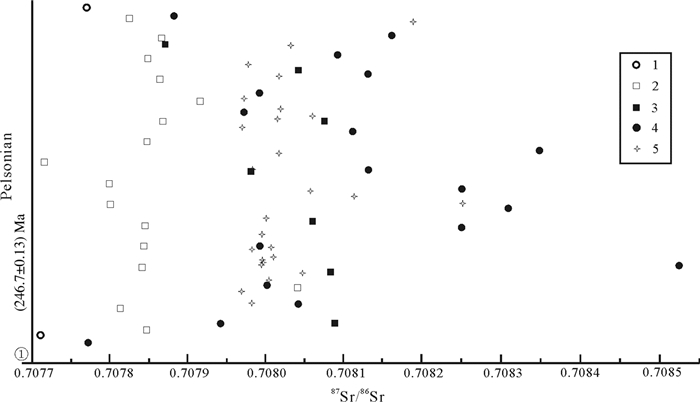Composition and evolution of strontium isotope from the fossiliferous layers of the Luoping biota, Yunnan
-
摘要:
现有公布的数据显示,海水87Sr/86Sr值在中三叠世安尼期较为平稳,有别于早三叠世因环境导致的动荡变化,为二叠纪末生物大灭绝之后生物复苏的加速期,而罗平生物群就是该加速期的标志性生物群。本文研究了含罗平生物群层位标准剖面-大凹子剖面上连续沉积的26件碳酸盐岩样品的锶同位素组成与演化,用于了解含罗平生物群层位沉积海水锶同位素的变化趋势。结果显示:(1)碳酸盐岩中Sr平均值大于2000×10-6,主要来自于文石和海洋成岩作用;(2)低Mn和Mn/Sr < 0.4说明:87Sr/86Sr数据在很大程度上能代表同时期海水中的87Sr/86Sr比值;(3)这些样品的87Sr/86Sr值变化在0.707969~0.708253,平均值为0.708025,锶同位素比值变化曲线呈小幅度的起伏波动,其值明显大于同时期欧洲等地公布的数据,但同华南其他地区公布的数据具有相似性,推测含罗平生物群层位锶同位素组成仅代表区域事件,受印支运动影响。
Abstract:The 87Sr/86Sr curve of seawater is relatively stable in the Anisian period of Middle Triassic according to data available, which is different from the situation of frequent changes in the Early Triassic. The recovery of marine ecosystem from the endPermian mass extinction experienced an accelerating phase during the Anisian period. The Luoping biota is one of the typical representatives of the Triassic biota. The authors studied the composition and evolution of the strontium isotope in 26 carbonate samples from the standard section, i.e., Dawazi section, of the Luoping biota, in order to know the change of strontium isotope from the fossiliferous layers which contain the Luoping biota. The results show three remarkable characteristics:(1) The average value of Sr is more than 2000×10-6 from the carbonate, which is mainly caused by the aragonite and diagenesis; (2) the low value of Mn and the Mn/Sr ratios less than 0.4 show that the these 87Sr/86Sr ratios can represent the composition of Sr isotope of the coeval seawater; (3) the ratios of 87Sr/86Sr of all samples range between 0.707969 and 0.708253, with the average ratio 0.708025. It is notable that the ratios of the 87Sr/86Sr are larger than the data for the same geological time published from Europe. Nevertheless, they are similar to Sr isotopic values from other areas in southern China. The authors therefore hold that the strontium isotope composition of the fossiliferous layers of the Luoping biota was not directly connected to global geological events, but affected by the regional event, such as the indosinian movement.
-
Keywords:
- strontium isotope /
- Luoping biota /
- Anisian period /
- marine carbonate rocks /
- Yunnan
-
1. 引言
二叠纪末期生物大灭绝是显生宙以来最大的生物灭绝事件,超过90%的古生代物种灭绝(Jin et al., 2000;Benton and Twitchett, 2003;Erwin,2006;Song et al., 2013)。虽然灭绝之后,各种门类的生物经历了不同复苏(Chen et al., 2002),但之后的生态系统全面复苏与辐射是发生在中三叠世安尼期(Hallam,1991;Payne et al., 2004;Tong et al., 2007b)。罗平生物群(Hu et al., 2011;Benton et al., 2013)是三叠纪生物全面复苏与辐射的标志性生物群,它是以食物链顶端的海洋爬行动物为主而重建的正常海洋生态系统(Solé et al., 2002;Hu et al., 2011;Chen and Benton, 2012),表明其已具有典型的中—新生代型生物和生态系统结构特征(童金南和殷鸿福,2009)。罗平生物群属于牙形石Nicoraella kockeli带(Zhang et al., 2009),时代为中三叠世安尼期的Pelsonian亚期(Kozur,2003),产于关岭组二段中部的灰黑色中薄层泥晶灰岩中。该类海相碳酸盐岩被认为是古海洋和大气化学的敏感指标(Galfetti et al., 2007),是研究罗平生物群特异埋藏机制的良好材料。
在全球海洋中海水的87Sr/86Sr同位素比值在任一时间是恒定的,海水的87Sr/86Sr比值是时间的函数,这是由于Sr在海水中的滞留时间(2.5~5 Ma)远远大于其在海洋中的混合时间(Broecker and Peng, 1982;McArthur,1994)。同一时间内海水锶同位素比值主要受壳源和幔源两个来源锶的控制(Palmer and Elderfield, 1985;Veizer et al., 1999;Boulton et al., 2007),而各种全球地质事件都会以不同方式改变海水中壳源锶和幔源锶的相对比值,它们是海水锶同位素组成与演化最为重要的控制因素(Bruckschen et al., 1995),因此海相碳酸盐岩的锶同位素比值的变化就能反映该时间内构造和气候等全球性事件。中三叠世安尼期Pelsonian亚期是在早三叠世恶劣环境之后出现的潮湿气候期,位于全球火山活动和CO2释放结束之后(Payne and Kump, 2007),适合海洋生物成长,是生物多样性的强增长期(Posenato,2008)。对处于该时期的罗平生物群,其层位海相碳酸盐岩锶同位素的组成与演化研究,能极大地完善罗平生物群特异埋藏机制,反演当时的海洋生态环境,以及进一步对了解二叠纪末生物大灭绝之后生物复苏与辐射机制具有重要意义。
2. 样品与方法
细结构的微晶碳酸盐岩已成为研究海相碳酸盐岩锶同位素组成的良好材料(Huang et al., 2008;Sawaki et al., 2010)。本文样品采自中三叠统关岭组二段含罗平生物群层位的大凹子剖面,该剖面位于云南省罗平县大凹子村西北约1000 m处(图 1),剖面起点地理坐标为24°46′13″N,104°19′3″E。该剖面是研究罗平生物群的典型剖面(Zhang et al., 2009;孙媛媛等,2009;黄金元等,2009;Hu et al., 2011),出露较好,以区域上野外岩性特征明显的、连续的、厚约1.4 m的灰黑色中厚层状含燧石结核灰岩为标志层(67~74层)(图 2),标志层之下主要为灰黑色极薄层状泥晶灰岩,含燧石结核、燧石条带泥晶灰岩,高丰度的鱼类化石主要产于第33、43层,第57、61层则以个体较大的海生爬行类动物化石为主;标志层之上可分为三段,下部主要为深灰色纹层状泥质灰岩偶夹燧石结核,其中第78~81层及第106层以大个体爬行类动物化石为主;中部以灰黑色薄层状泥晶灰岩为主,平行层理、波状纹理、滑塌构造和包卷层理发育;上部主要以灰黑色中厚层状砂屑、砾屑灰岩为主。
为了保证所获得的样品能尽可能代表原始海水的锶同位素组成,采样过程中没有采集亮晶胶结的各种颗粒灰岩和结晶灰岩,而采集未发生重结晶的泥晶-微晶灰岩、泥晶颗粒灰岩、颗粒泥晶灰岩、腕足类化石的外壳以及少量的含白云质灰岩、白云质灰岩作为测试样品。借助双目镜对用于分析样品进行细致的分拣,回避方解石脉和亮晶方解石胶结物。样品经挑选后粉碎至200目,并分成2份:一份测定SiO2、CaO、MgO、Mn和Sr含量,另一份测定锶同位素比值。
SiO2、CaO、MgO、Mn和Sr含量分析是由国土资源部西南矿产资源监督检查中心完成。SiO2的含量利用重量法测定,检出限是0.1%;CaO,MgO,Mn和Sr含量用全谱直读等离子体光谱测定,检出限是15μg/g;误差皆小于1%。锶同位素分析是由中国地质大学(武汉)地质过程与矿产资源国家重点实验室进行,分析使用的仪器为热电离同位素质谱仪(TIMS),仪器型号是Triton Ti。国际标样NBS987的87Sr/86Sr实测值为0.710266±7(2σ)。
3. 样品Mn和Sr含量及Mn/Sr比值
海相碳酸盐岩的成岩蚀变过程是一个锰的获取过程和锶的丢失过程(Brand and Veizer, 1980),因而碳酸盐岩组分的Mn和Sr含量与Mn/Sr比值是判断海相碳酸盐岩成岩作用、蚀变程度以及其对海水信息代表程度的灵敏指标(Kaufman and Knoll, 1995;Veizer et al., 1999;Huang et al., 2008)。在表 1所列的中三叠统关岭组二段含罗平生物群层位的26个样品中,大多数样品具有较高的Sr含量(全部样品的平均含量为2117×10-6)和较低的Mn含量(全部样品的平均含量为51×10-6),相应的Mn/Sr值也是比较小的(全部样品的平均值为0.09),都大于或远远大于Derry et al.(1989)建议的锶同位素地层学研究中样品的Sr含量下限值200×10-6,不少样品还大于Korte et al. (2003)建议的锶同位素地层学研究中好样品的Sr含量下限值400×10-6,同时所有样品满足Korte et al. (2003)建议的锶同位素地层学研究中好样品的Mn含量上限值250×10-6,且全部样品相应的Mn/Sr值也都显著小于Kaufman et al. (1992)建议的锶同位素地层学研究中样品的Mn/Sr值上限值2~3,那么可以认为含罗平生物群层位海相碳酸盐岩样品只遭受了有限的成岩蚀变(Denison et al., 1994b),对海水信息具有较好的保存性。同时通过该剖面碳酸盐岩样品δ13C和δ18O数据点相关性差以及δ18OPDB > -5‰的特点,判断该剖面灰岩样品受后期大气水参与的成岩作用的影响较小(孙媛媛等,2009)。
表 1 大凹子剖面碳酸盐岩的87Sr/86Sr值及其相应的SiO2、CaO、MgO、Sr和Mn含量Table 1. The 87Sr/86Sr ratios and corresponding concentrations of SiO2, CaO, MgO, Sr and Mn of marine carbonates from Dawazi section
4. Sr同位素比值结果
含罗平生物群层位海相碳酸盐岩样品的锶同位素组成分析结果(表 1, 图 2)表明, 所有样品的87Sr/86Sr值为0.707969~0.708253,平均值为0.708025,比现代海水的锶同位素比值0.709073低(Denison et al., 1994a)。根据获得的样品锶同位素组成数据,大凹子剖面中三叠世安尼期的锶同位素组成演化曲线可细分为4个阶段:(1)从第1层到第73层,累积厚度0~ 5.8 m;包括12个样品的87Sr/86Sr值,其变化较为平稳,在平均值0.707999附近小幅度震荡,最大值与最小值间相差0.000078;(2)从第74层到第111层,累积厚度5.8~9 m;包括4个样品的87Sr/86Sr值,其变化较大,前段急剧上升,后段急剧下降;是整个剖面锶同位素组成演化曲线中平均变化最快的一段曲线,且包括演化曲线中的最大值(0.708253);(3)从第112层到第160层,累积厚度9~16 m;包括8个样品的87Sr/86Sr值,其在平均值0.708006附近震荡,其间包括三次小震荡,层号111~122、136~141、149~156层上升和122~136、141~149、156~160层下降;(4)从161层到168层,累积厚度从16~18.6 m;包括2个样品的87Sr/86Sr值,其值平稳上升。
5. 讨论
5.1 数据对比
本文测得的锶同位素比值来自同一条连续沉积的碳酸盐岩剖面,样品考虑了成岩蚀变的因素进行了严格的筛选,通过对Mn/Sr比值判断,含罗平生物群层位海水锶同位素组成能较好地代表原始海水。而该值能否代表中三叠世Pelsoian亚期全球海水锶同位素比值组成,这取决于:(1)是否当时的海水处于开放连通的海洋环境;(2)是否当时海洋锶同位素组成在该时间尺度上是均一的;(3)测试的锶同位素组成在多大程度上仅反映的是区域变化。通过对大凹子剖面沉积构造研究表明:罗平生物群产出于台间盆地相钙屑浊流沉积环境(黄金元等,2009);区域地质调查支持该时期为开放的海洋系统;同时,罗平生物群为该时期典型的生物群落(Hu et al., 2011),这些都指出大凹子剖面锶同位素组成具有区域性。通过对不同古地理位置的锶同位素组成进行对比,发现安尼期Pelsonian亚期海水87Sr/86Sr震荡幅度较小,有别于早三叠世锶同位素值的急剧上升(Korte et al., 2003;Huang et al., 2008;Hu et al., 2008;Song et al., 2015),为二叠纪末生物大灭绝之后生物复苏的加速期。黄思静等(2006)认为这种稳定性与二叠系—三叠系界线之上,全球海平面持续上升背景下,大范围分布的陆表海对放射性成因锶的保护有关,同时该时间间隔中也没有显著的造山事件和洋中脊的异常热液活动,从而造成了该时间间隔中海水锶同位素比值的相对稳定。同样,从碳同位素来看,早三叠世呈大幅度波动,到中三叠世安尼期后变为稳定(Payne et al., 2004;Huang et al., 2012),这种早三叠世碳、锶同位素的特色性对应该时期恶劣的环境和间隙性的环境事件有关(Tong et al., 2007a;谢韬等,2013)。
值得注意的是,罗平地区中三叠世Pelsoian亚期锶同位素比值明显高于同时期Korte et al.(2003)、Veizer et al. (1999)在匈牙利巴拉顿高地和Koepnick et al. (1990)在德国测得的数据,但同Hu et al.(2008)、常晓林等(2010)在四川东部以及Song et al.(2015)在贵州青岩、罗甸地区测得的数据相近(图 3),我们可以推测这仅代表扬子地区锶同位素组成,具有区域性。罗平地区中三叠世受印支运动影响(梅冥相,2010),大陆抬升,陆地遭受风化作用影响的面积增大,经古老岩石风化剥蚀而带入海水的富放射性成因的锶也相应增加,造成海水锶同位素比值的相对上升。殷鸿福等(1994)认为在扬子地区早三叠世中期海侵达到高峰后由于扬子、华北陆内碰撞使扬子整体抬升,海平面下降,这一长期变化与全球变化不符,但在东亚具有代表性,反映发生在中三叠世后期的印支运动对整个东亚的影响。那么,扬子地区锶同位素比值的变化反映仅是受印支运动影响的区域事件。
![]() 图 3 中三叠世Pelsoian亚期锶同位素变化趋势图1—据Koepnick等(1990);2—据Korte等(2003);3—据Hu等(2008);4—据Song等(2015);5—本文数据。
图 3 中三叠世Pelsoian亚期锶同位素变化趋势图1—据Koepnick等(1990);2—据Korte等(2003);3—据Hu等(2008);4—据Song等(2015);5—本文数据。
①参考贵州关刀剖面凝灰岩锆石U-Pb年龄为(246.77±0.13)Ma(Lehrmann et al., 2006)Figure 3. 87Sr/86Sr trend of Pelsoian seawater1- after Koepnick et al. 1990; 2-after Korte et al. 2003; 3-after Hu et al. 2008; 4-after Song et al. 2015; 5-this work
① Tuff zircon U-Pb age of Guangdao profile in Guizhou(246.77±0.13) Ma (after Lehrmann et al., 2006)5.2 含罗平生物群层位锶同位素组成变化成因探讨
本文来自含罗平生物群化石连续沉积的碳酸盐岩样品的锶同位素比值是该时期区域性的真实记录,由于样品归于同一个牙形石带,不是长时间刻度的变化,高频波动的锶同位素不能被归集到一个时间点上,仅具有区域意义,受地方性局部事件和古地理环境影响。在锶同位素的周期波动中,锶同位素比值相对较高值对应岩相为砂屑灰岩相,指示能量较高;比值减少指向泥晶相、灰泥相,指示能量较低。动态地反映了含罗平生物群层位海平面的升降的高频波动。已有的研究显示,当海平面上升时,陆地遭受风化作用影响的面积减小,经古老岩石风化剥蚀而带入海水的富放射性成因的锶也相应减少,同时此时也是海底扩张加速、洋中脊火山作用和热液活动加剧期,向海水提供大量非放射性成因的幔源锶,造成海水锶同位素比值的相对下降;反之,便会造成海水中锶同位素比值的相对升高。因此,海水的锶同位素比值与海平面变化呈负相关关系(黄思静,1997;李荣西等,2000;Jiang et al., 2001;黄思静等,2002;严兆彬等,2005)。
在锶同位素的周期波动中,第(1)阶段87Sr/86Sr值平稳波动反映出环境安稳,为生物的复苏提供了良好的环境。第(2)阶段的锶同位素的快速上升与下降对应海平面的急速波动,以及所在的特殊的古地理环境(黄金元等,2009),导致该时期海洋间隙性的缺氧,大量生物死亡,富集;从化石富集来看,第一阶段末和第二阶段初为罗平生物群古生物化石种类和数量最为密集的层位,也可能与周期性循环之间锶同位素比值轻微减少,反映更大规模的构造或岩浆活动(Rhodes et al., 2002)而导致生物的死亡和埋藏有关。在第(3)阶段中,87Sr/86Sr值的频繁动荡,反映了海平面的动荡变化,这在该地层中表现为滑塌构造、包卷层理发育;在第(4)阶段中,87Sr/86Sr值平稳上升,其上覆地层出露杨柳井白云岩,对应扬子地块拉丁期海退事件(殷鸿福等,1994;李荣西等,2003)。
6. 结论
通过对含罗平生物群层位标准剖面——大凹子剖面上连续沉积的26件碳酸盐岩样品进行锶同位素测试,获得了该时期沉积海水锶同位素的变化趋势呈小幅度的起伏波动,对比其他地区公布的数据,推测受印支运动影响含罗平生物群层位锶同位素组成仅代表区域事件。
根据获得的样品锶同位素组成数据,演化曲线可细分为4个阶段,指出锶同位素在第一阶段末和第二阶段初的快速上升所反应的环境变化可能与罗平生物群的死亡和埋藏有关。
致谢: 中国地质大学地质过程与矿产资源国家重点实验室周炼教授在锶同位素的分析实验中提供了大量帮助,在此表示衷心的感谢! -
图 3 中三叠世Pelsoian亚期锶同位素变化趋势图
1—据Koepnick等(1990);2—据Korte等(2003);3—据Hu等(2008);4—据Song等(2015);5—本文数据。
①参考贵州关刀剖面凝灰岩锆石U-Pb年龄为(246.77±0.13)Ma(Lehrmann et al., 2006)Figure 3. 87Sr/86Sr trend of Pelsoian seawater
1- after Koepnick et al. 1990; 2-after Korte et al. 2003; 3-after Hu et al. 2008; 4-after Song et al. 2015; 5-this work
① Tuff zircon U-Pb age of Guangdao profile in Guizhou(246.77±0.13) Ma (after Lehrmann et al., 2006)表 1 大凹子剖面碳酸盐岩的87Sr/86Sr值及其相应的SiO2、CaO、MgO、Sr和Mn含量
Table 1 The 87Sr/86Sr ratios and corresponding concentrations of SiO2, CaO, MgO, Sr and Mn of marine carbonates from Dawazi section

-
Benton M J, Twitchett R J. 2003. How to kill (almost) all life:The end-Permian extinction event[J]. Trends in Ecology and Evolution, 18(7):358-365. doi: 10.1016/S0169-5347(03)00093-4
Benton M J, Zhang Qiyue, Hu Shixue, Chen Zhongqiang, Wen Wen, Liu Jun, Huang Jinyuan, Zhou Changyong, Xie Tao, Tong Jinnan, Choo B. 2013. Exceptional vertebrate biotas from the Triassic of China, and the expansion of marine ecosystems after the PermoTriassic mass extinction[J]. Earth-Science Reviews, 125:199-243. doi: 10.1016/j.earscirev.2013.05.014
Boulton S J, Robertson A H F, Ellam R M, Safak Ü, Can Ü N G C. 2007. Strontium Isotopic and Micropalaeontological Dating Used to Help Redefine the tratigraphy of the Neotectonic Hatay Graben, Southern Turkey[J]. Turkish Journal of Earth Sciences, 16:141-179.
Brand U, Veizer J. 1980. Chemical diagenesis of a multicomponent carbonate system-1:Trace elements[J]. Journal of Sedimentary Petrology, 50:1219-1236.
Broecker W S, Peng T H. 1982. Tracers in the Sea[M]. New York:Eldigio Press.
Bruckschen P, Bruhn F, Veizer J, Buhl D. 1995. 87Sr/86Sr isotopic evolution of Lower Carboniferous seawater:Dinantian of western Europe[J]. Sedimentary Geology, 100:63-81. doi: 10.1016/0037-0738(95)00103-4
Chang Xiaolin, Shi He, Luo Wei, Song Ying, Wan Mingli. 2010. Sr isotopic curve of the Lower-Middle Triassic of East Sichuan and the chronostratigraphic division[J]. Journal of chengdu University of Technology(Science & Technology edition), 37(1):9-14(in Chinese with English abstract). http://www.wanfangdata.com.cn/details/detail.do?_type=perio&id=cdlgxyxb201001002
Chen Z Q, Benton M J. 2012. The timing and pattern of biotic recovery following the end-Permian mass extinction[J]. Nature Geoscience, 5(6):375-383. doi: 10.1038/ngeo1475
Chen Z Q, Shi G R, Kaiho K. 2002. A New Genus of Rhynchonellid Brachiopod from the Lower Triassic of South China and Implications for Timing the Recovery of Brachiopoda After the End-Permian Mass Extinction[J]. Palaeontology, 45(1):149-164. doi: 10.1111/pala.2002.45.issue-1
Denison R E, Koepnick R B, Burke W H, Hetherington E A, Fletcher A. 1994a. Construction of the Mississippian, Pennsylvanian and Permian seawater 87Sr/86Sr curve[J]. Chemical geology, 112:145-167. doi: 10.1016/0009-2541(94)90111-2
Denison R E, Koepnick R B, Fletcher A, Howell M W, Callaway W S. 1994b. Criteria for the retention of original seawater in ancient shelf limestones[J]. Chemical Geology, 112:131-143. doi: 10.1016/0009-2541(94)90110-4
Derry L A, Keto L S, Jacobsen S B, Knoll A H, Swett K. 1989. Sr isotopic variations in Upper Proterozoic carbonates from Svalbard and East Greenland[J]. Geochimica et Cosmochimica Acta, 53(9):2331-2339. doi: 10.1016/0016-7037(89)90355-4
Erwin D H. 2006. Extinction:How Life on Earth Nearly Ended 250 Million Years Ago[M]. Princeton:Princeton University Press.
Galfetti T, Bucher H, Brayard A, Hochuli P A, Weissert H, Guodun K, Atudorei V, Guex J. 2007. Late Early Triassic climate change:insights from carbonate carbon isotopes, sedimentary evolution and ammonoid paleobiogeography[J]. Palaeogeography, Palaeoclimatology, Palaeoecology, 243(3):394-411. http://d.old.wanfangdata.com.cn/NSTLQK/NSTL_QKJJ023718390/
Hallam A. 1991. Why was there a delayed radiation after the endPalaeozoic extinctions?[J]. Historical Biology, 5(2/4):257-262. doi: 10.1080/10292389109380405
Hu Shixue, Zhang Qiyue, Chen Zhongqiang, Zhou Changyong, Lü Tao, Xie Tao, Wen Wen, Huang Jinyuan, Benton M J. 2011. The Luoping biota:exceptional preservation, and new evidence on the Triassic recovery from end-Permian mass extinction[J]. Proceeding of the Royal Society B, 278:2274-2282. doi: 10.1098/rspb.2010.2235
Hu Zuowei, Huang Sijing, Qing Hairuo, Wang Qingdong, Wang Chunmei, Gao Xiaoyong. 2008. Evolution and global correlation for strontium isotopic composition of marine Triassic from Huaying Mountains, eastern Sichuan, China[J]. Science in China Series D:Earth Sciences, 51(4):540-549. doi: 10.1007/s11430-008-0031-6
Huang Jinyuan, Zhang Kexin, Zhang Qiyue, Lü Tao, Zhou Changyong, Bai Jianke. 2009. Conodonts stratigraphy and sedimentary environment of the Middle Triassic at Daaozi section of Luoping county, Yunnan Province, South China[J]. Acta Micropalaeontologica Sinica, 26(3):211-224(in Chinese with English abstract). http://www.wanfangdata.com.cn/details/detail.do?_type=perio&id=wtgswxb200903002
Huang Sijing. 1997. A Study on carbon and strontium isotopes of late paleozoic carbonate rocks in the upper Yangtze platform[J]. Acta Geologica Sinica, 71(1):45-53(in Chinese with English abstract). http://www.wanfangdata.com.cn/details/detail.do?_type=perio&id=QK199700067621
Huang Sijing, Huang Keke, Lü Jie, Lan Yefang. 2012. Carbon isotopic composition of Early Triassic marine carbonates, Eastern Sichuan Basin, China[J]. Science China(Earth Sciences), 55(12):2026-2038. doi: 10.1007/s11430-012-4440-1
Huang Sijing, Qing Hairuo, Huang Peipei, Hu Zuowei, Wang Qingdong, Zou Mingliang, Liu Haonian. 2008. Evolution of strontium isotopic composition of seawater from Late Permian to Early Triassic based on study of marine carbonates, Zhongliang Mountain, Chongqing, China[J]. Science in China (Series D):Earth Sciences, 51(4):528-539. doi: 10.1007/s11430-008-0034-3
Huang Sijing, Shi He, Zhang Meng, Wu Wenhui, Shen Licheng. 2002.Global correlation of strontium isotope evolution curve of Devonian in Longmen mountain and dating marine sediments[J]. Progress in Natural Science, 12(9):945-951(in Chinese).
Huang Sijing, Sun Zhilei, Wu Sujuan, Zhang Meng, Pei Changrong, Hu Zuowei. 2006. Strontium isotope composition and control factors of global sea water in Triassic[J]. Journal of Mineralogy and Petrology, 26(1):43-48(in Chinese with English abstract). http://en.cnki.com.cn/Article_en/CJFDTOTAL-KWYS200601008.htm
Jiang Maosheng, Zhu Jiangquan, Chen Daizhao, Zhang Renhu, Qiao Guangsheng. 2001. Carbon and strontium isotope variations and responses to sea-level fluctuations in the Ordovician of the Tarim Basin[J]. Science in China (Series D):Earth Sciences, 44(9):816-823. doi: 10.1007/BF02907094
Jin Y G, Wang Y, Wang W, Shang Q H, Cao C Q, Erwin D H. 2000.Pattern of marine mass extinction near the Permian-Triassic boundary in South China[J]. Science, 289(5478):432-436. doi: 10.1126/science.289.5478.432
Kaufman A J, Knoll A H. 1995. Neoproterozoic variations in the Cisotopic composition of seawater:stratigraphic and biogeochemical implications[J]. Precambrian Research, 73:27-49. doi: 10.1016/0301-9268(94)00070-8
Kaufman A J, Knoll A H, Awramik S M. 1992. Biostratigraphic and chemostratigraphic correlation of Neoproterozoic sedimentary successions:Upper Tindir Group, northwestern Canada, as a test case[J]. Geology, 20(2):181-185. doi: 10.1130/0091-7613(1992)020<0181:BACCON>2.3.CO;2
Koepnick R B, Denison R E, Burke W H, Hetherington E A, Dahl D A. 1990. Construction of the Triassic and Jurassic portion of the Phanerozoic curve of seawater 87Sr/86Sr[J]. Chemical Geology:Isotope Geoscience section, 80(4):327-349. doi: 10.1016/0168-9622(90)90014-4
Korte C, Kozur H W, Bruckschen P, Veizer J. 2003. Strontium isotope evolution of Late Permian and Triassic seawater[J]. Geochimica et Cosmochimica Acta, 67(1):47-62. doi: 10.1016/S0016-7037(02)01035-9
Kozur H W. 2003. Integrated ammonoid, conodont and radiolarian zonation of the Triassic and some remarks to stage/substage subdivision and the numeric age of the Triassic stages[J]. Albertiana, 28:57-74.
Lehrmann D J, Ramezani J, Bowring S A, Martin M W, Montgomery P, Enos P, Payne J L, Orchard M J, Hongmei W, Jiayong W. 2006.Timing of recovery from the end-Permian extinction:geochronologic and biostratigraphic constraints from south China[J]. Geology, 34(12):1053-1056. doi: 10.1130/G22827A.1
Li Rongxi, Wei Jiayong, Xiao Jiafei, Wang Xingli, Lehrmann D J. 2003. Early-Middle Triassic sedimentary facies and LadinianCarnian transgression in southwestern Guizhou Province, South China[J]. Journal of Changpan University (Earth Science Edition), 25(3):1-6(in Chinese with English abstract).
Li Rongxi, Wei Jiayong, Yan Weidong, Guo Qingjun. 2000. Variations of ratio of 87Sr/86Sr in seawater with time:Implications for sea level changes and global correlation[J]. Advance in Earth Sciences, 15(6):729-733(in Chinese with English abstract). http://en.cnki.com.cn/Article_en/CJFDTOTAL-DXJZ200006018.htm
Mcarthur J M. 1994. Recent trends in strontium isotope stratigraphy[J]. Terra Nova, 6(4):331-358. doi: 10.1111/ter.1994.6.issue-4
Mei Mingxiang. 2010. Stratigraphic impact of the Indo-China Movement and its related evolution of sedimentary-basin pattern of the late Triassic in the middle-upper Yangtze Region[J]. Earth Science Frontiers(4):99-111(in Chinese with English abstract). http://www.wanfangdata.com.cn/details/detail.do?_type=perio&id=dxqy201004008
Palmer M R, Elderfield H. 1985. Sr isotope composition of sea water over the past 75 Myr[J]. Nature, 314:526-528. doi: 10.1038/314526a0
Payne J L, Kump L R. 2007. Evidence for recurrent Early Triassic massive volcanism from quantitative interpretation of carbon isotope fluctuations[J]. Earth and Planetary Science Letters, 256:264-277. doi: 10.1016/j.epsl.2007.01.034
Payne J L, Lehrmann D J, Wei J, Orchard M J, Schrag D P, Knoll A H. 2004. Large perturbations of the carbon cycle during recovery from the end-Permian extinction[J]. Science, 305:506-509. doi: 10.1126/science.1097023
Posenato R. 2008. Patterns of bivalve biodiversity from Early to Middle Triassic in the Southern Alps (Italy):Regional vs. global events[J]. Palaeogeography, Palaeoclimatology, Palaeoecology, 261(1):145-159. https://www.sciencedirect.com/science/article/pii/S0031018208000527
Rhodes M K, Carroll A R, Pietras J T, Beard B L, Johnson C M. 2002.Strontium isotope record of paleohydrology and continental weathering, Eocene Green River Formation, Wyoming[J]. Geology, 30(2):167-170. doi: 10.1130/0091-7613(2002)030<0167:SIROPA>2.0.CO;2
Sawaki Y, Kawai T, Shibuya T, Tahata M, Omori S, Komiya T, Yoshida N, Hirata T, Ohno T, Windley B F. 2010. 87Sr/86Sr chemostratigraphy of Neoproterozoic Dalradian carbonates below the Port Askaig glaciogenic formation, Scotland[J]. Precambrian Research, 179(1/4):150-164. http://www.wanfangdata.com.cn/details/detail.do?_type=perio&id=c8ca03192b7b7021d285efd9d97ad0b8
Solé R V, Montoya J M, Erwin D H. 2002. Recovery after mass extinction:evolutionary assembly in large-scale biosphere dynamics[J]. Philosophical Transactions of the Royal Society of London. Series B:Biological Sciences, 357(1421):697-707. doi: 10.1098/rstb.2001.0987
Song Haijun, Wignall P B, Tong Jinnan, Yin Hongfu. 2013. Two pulses of extinction during the Permian-Triassic crisis[J]. Nature Geoscience, 6(1):52-56. https://www.researchgate.net/publication/258807265_Two_pulses_of_extinction_during_the_Permian-Triassic_crisis?ev=auth_pub
Song Haijun, Wignall P B, Tong Jinnan, Song Huyue, Chen Jing, Chu Daoliang, Tian Li, Luo Mao, Zong Keqing, Chen Yanlong, Lai Xulong, Zhang Kexin, Wang Hongmei. 2015. Integrated Sr isotope variations and global environmental changes through the Late Permian to early Late Triassic[J]. Earth and Planetary Science Letters, 424:140-147. doi: 10.1016/j.epsl.2015.05.035
Sun Yuanyuan, Liu Jun, Lü Tao, Xu Xiaosong, Zhang Qiyue, Lou Xiongying, Jiang Xinsheng. 2009. Oxygen and carbon isotopic compositions of Middle Triassic carbonates from the Dawazi Section of Luoping, Yunnan:Implications for paleoenvironment of the Luoping Lagerstätte[J]. Acta Geological Sinica, 83(8):1110-1117(in Chinese with English abstract). http://en.cnki.com.cn/Article_en/CJFDTOTAL-DZXE200908010.htm
Tong Jinnan, Yin Hongfu. 2009. Advance in the study of early triassic life and environment[J]. Acta Palaeontologica Sinica, 48(3):497-508(in Chinese with English abstract). http://www.wanfangdata.com.cn/details/detail.do?_type=perio&id=gswxb200903020
Tong Jinnan, Zhang Suxin, Zuo Jingxun, Xiong Xinqi. 2007a. Events during Early Triassic recovery from the end-Permian extinction[J]. Global and Planetary Change, 55(1):66-80. http://www.sciencedirect.com/science/article/pii/S0921818106001391
Tong Jinnan, Zuo Jingxun, Chen Z Q. 2007b. Early Triassic carbon isotope excursions from South China:Proxies for devastation and restoration of marine ecosystems following the end-Permian mass extinction[J]. Geological Journal, 42:371-389. doi: 10.1002/(ISSN)1099-1034
Veizer J, Ala D, Azmy K, Bruckschen P, Buhl D, Bruhn F, Carden G A F, Diener A, Ebneth S, Godderis Y. 1999. 87Sr/86Sr, δ13C and δ18O evolution of Phanerozoic seawater[J]. Chemical Geology, 161:59-88. doi: 10.1016/S0009-2541(99)00081-9
Xie Tao, Zhou Changyong, Zhang Qiyue, Hu Shixue, Huang Jinyuan, Wen Wen, Cong Feng. 2013. Zircon U-Pb age for the tuff before the Luoping Biota and its geological implication[J]. Geological Review, 59(1):159-164(in Chinese with English abstract). http://www.wanfangdata.com.cn/details/detail.do?_type=perio&id=dzlp201301017
Yan Zhaobin, Guo Fusheng, Pan Jiayong, Guo Guolin, Zhang Yuejing. 2005. Application of C, O and Sr isotope composition of carbonates in the research of paleoclimate and paleooceanic environment[J]. Contributions to Geology and Mineral Resources Research, 20(1):53-56(in Chinese with English abstract). http://www.wanfangdata.com.cn/details/detail.do?_type=perio&id=dzzklc200501010
Yin Hongfu, Tong Jinnan, Ding Meihua, Zhang Kexin, Lai Xulong. 1994. Late Permian-Middle Triassic sea level changes of Yangtze platform[J]. Earth Science, 19(5):627-632(in Chinese with English abstract). http://www.wanfangdata.com.cn/details/detail.do?_type=perio&id=QK199400042369
Zhang Qiyue, Zhou Changyong, Lü Tao, Xie Tao, Lou Xiongying, Liu Wei, Sun Yuanyuan, Huang Jinyuan, Zhao Laishi. 2009. A conodont-based Middle Triassic age assignment for the Luoping Biota of Yunnan, China[J]. Science in China (Series D):Earth Sciences, 52(10):1673-1678. doi: 10.1007/s11430-009-0114-z
常晓琳, 石和, 罗威, 宋莹, 万明礼. 2010.川东地区下-中三叠统的锶同位素曲线及年代地层划分[J].成都理工大学学报(自然科学版), 37(1):9-14 doi: 10.3969/j.issn.1671-9727.2010.01.002 黄金元, 张克信, 张启跃, 吕涛, 周长勇, 白建科. 2009.云南罗平中三叠世大凹子剖面牙形石生物地层及其沉积环境研究[J].微体古生物学报, 26(3):211-224 doi: 10.3969/j.issn.1000-0674.2009.03.002 黄思静. 1997.上扬子地台区晚古生代海相碳酸盐岩的碳、锶同位素研究[J].地质学报, 71(1):45-53 http://www.wanfangdata.com.cn/details/detail.do?_type=perio&id=QK199700067621 黄思静, 石和, 张萌, 武文慧, 沈立成. 2002.龙门山泥盆纪锶同位素演化曲线的全球对比及海相地层的定年[J].自然科学进展, 12(9):945-951. doi: 10.3321/j.issn:1002-008X.2002.09.010 黄思静, 孙治雷, 吴素娟, 张萌, 裴昌蓉, 胡作维. 2006.三叠纪全球海水的锶同位素组成及主要控制因素[J].矿物岩石, 26(1):43-48 doi: 10.3969/j.issn.1001-6872.2006.01.009 李荣西, 魏家庸, 肖家飞, 王兴理, Lehrmann D J. 2003.黔西南地区早-中三叠世沉积岩相与Ladinian-Carnian期大海侵[J].长安大学学报(地球科学版), 25(3):1-6. doi: 10.3969/j.issn.1672-6561.2003.03.001 李荣西, 魏家庸, 杨卫东, 郭庆军. 2000.用87Sr/86Sr研究海平面变化与全球对比问题[J].地球科学进展, 15(6):729-733. doi: 10.3321/j.issn:1001-8166.2000.06.019 梅冥相. 2010.中上扬子印支运动的地层学效应及晚三叠世沉积盆地格局[J].地学前缘, 17(4):99-111. http://d.old.wanfangdata.com.cn/Periodical/dxqy201004008 孙媛媛, 刘俊, 吕涛, 许效松, 张启跃, 楼雄英, 江新胜. 2009.罗平生物群产出层位氧碳稳定同位素的初步研究[J].地质学报, 83(8):1110-1117. doi: 10.3321/j.issn:0001-5717.2009.08.008 童金南, 殷鸿福. 2009.早三叠世生物与环境研究进展[J].古生物学报, 48(3):497-508. doi: 10.3969/j.issn.0001-6616.2009.03.020 谢韬, 周长勇, 张启跃, 胡世学, 黄金元, 文芠, 丛峰. 2013.罗平生物群下部凝灰岩锆石年龄及其地质意义[J].地质论评, 59(1):159-164. doi: 10.3969/j.issn.0371-5736.2013.01.017 严兆彬, 郭福生, 潘家永, 郭国林, 张曰静. 2005.碳酸盐岩C, O, Sr同位素组成在古气候、古海洋环境研究中的应用[J].地质找矿论丛, 20(1):53-56. doi: 10.3969/j.issn.1001-1412.2005.01.010 殷鸿福, 童金南, 丁梅华, 张克信, 赖旭龙. 1994.扬子区晚二叠世-中三叠世海平面变化[J].地球科学, 19(5):627-632. doi: 10.3321/j.issn:1000-2383.1994.05.004 -
期刊类型引用(3)
1. 黄金元,胡世学,张启跃,周长勇,文芠,马志鑫. 云南中三叠世罗平生物群首次发现硅质海绵骨针化石. 地质通报. 2022(12): 2167-2172 .  百度学术
百度学术
2. 苗忠英,郑绵平,娄鹏程,张雪飞,孙海涛,张震,徐其辉,杜雪苗. 云南思茅盆地钾盐矿床的深源浅储成因模式——来自于Sr同位素的证据. 中国地质. 2022(06): 1923-1935 .  本站查看
本站查看
3. 丁仲昭,马志鑫,张启跃,文芠,胡世学,范可静,蔡金君,李润根. 云南罗平江边地区中三叠统关岭组二段古环境特征. 沉积学报. 2021(06): 1406-1424 .  百度学术
百度学术
其他类型引用(2)




 下载:
下载:


